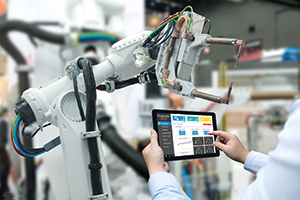

Looking to industry’s future with all the advancements in technology that the IIoT holds, one might wonder if pneumatics will still have pride of place on the production line. After all, it is just gas or air passing through tubes. Surely, all the innovation happening around digitalisation will mean that IIoT components will become more important than their pneumatic counterparts?
Pneumatics and IIoT inseparable
The real answer is that the two technologies will most likely become inseparable because they perform equally important functions that are becoming increasingly interdependent. Parker’s recent ‘Factory of the Future’ market research has revealed that pneumatic technology will indeed remain a critical component in the digital manufacturing field for the foreseeable future. Although pneumatic equipment functions through pressurised gas or air moving through tubes, these tubes remain the ‘veins’ of the factory, delivering fast, precise and efficient movement on complex automation lines and facilitating quick and easy assembly, cleaning and a host of other functions on the production floor.
Pneumatic designs complement Industry 4.0
Since pneumatics have been around for quite some time, devices already offer high reliability and efficiency and their designs naturally complement the modular approach of Industry 4.0. In the increasingly digital manufacturing sphere, pneumatic systems are being adapted to answer the need for real-time process data through the incorporation of IIoT-enabled nodes and sensors.
While some pneumatics manufacturers have been slow off the mark to follow the digitalisation trend, Parker recognised the opportunity to serve customers with industry-leading connectivity and safety solutions well in advance. For instance, its entire product development cycle is now focused on making devices smart by ensuring that they can communicate their status to the rest of the network. OEMs can now easily use the smart pneumatics equipped with cost-efficient sensors to monitor the real-time status, positioning, velocity, condition and efficiency of the various components that make up the modern automation line.
Although there is still a long way to go before the vision of Industry 4.0 is realised, the intermediate period will see the gradual introduction of these smart products that offer both traditional control functions and actionable intelligence. The evolution of manufacturing is contingent upon the development and continuous improvement of this actionable intelligence, giving users the ability to track the uptime and availability of the machines in their plant. The analytics from this data will enable significant operational cost savings, for instance, by performing predictive maintenance and achieving optimised operations using continuous position sensing.
Future-proof designs
While the technology is still in a state of flux, machine builders and their component suppliers will now need to make careful choices to future-proof their designs. Parker believes that open-source, low-cost industrial Ethernet (IE)-based components and subsystems is the answer to this challenge and so product development efforts have been based on IO-Link enabled connectivity and network solutions.
IO-Link enabled products are just one example of how Parker is providing customers with cutting edge technologies for use in globalised manufacturing operations. Regardless of location, the use of IE and IO-Link network nodes make the control, safety and maintenance of a range of different devices, machines, systems and users simple and cost-effective.
Ensuring that key automation components such as pneumatic valves are IIoT-enabled is an excellent way of creating opportunities for innovation in the factory of the future.
| Tel: | +27 11 961 0700 |
| Email: | [email protected] |
| www: | www.parker.com/za |
| Articles: | More information and articles about Parker Hannifin - Sales Company South Africa |

© Technews Publishing (Pty) Ltd | All Rights Reserved